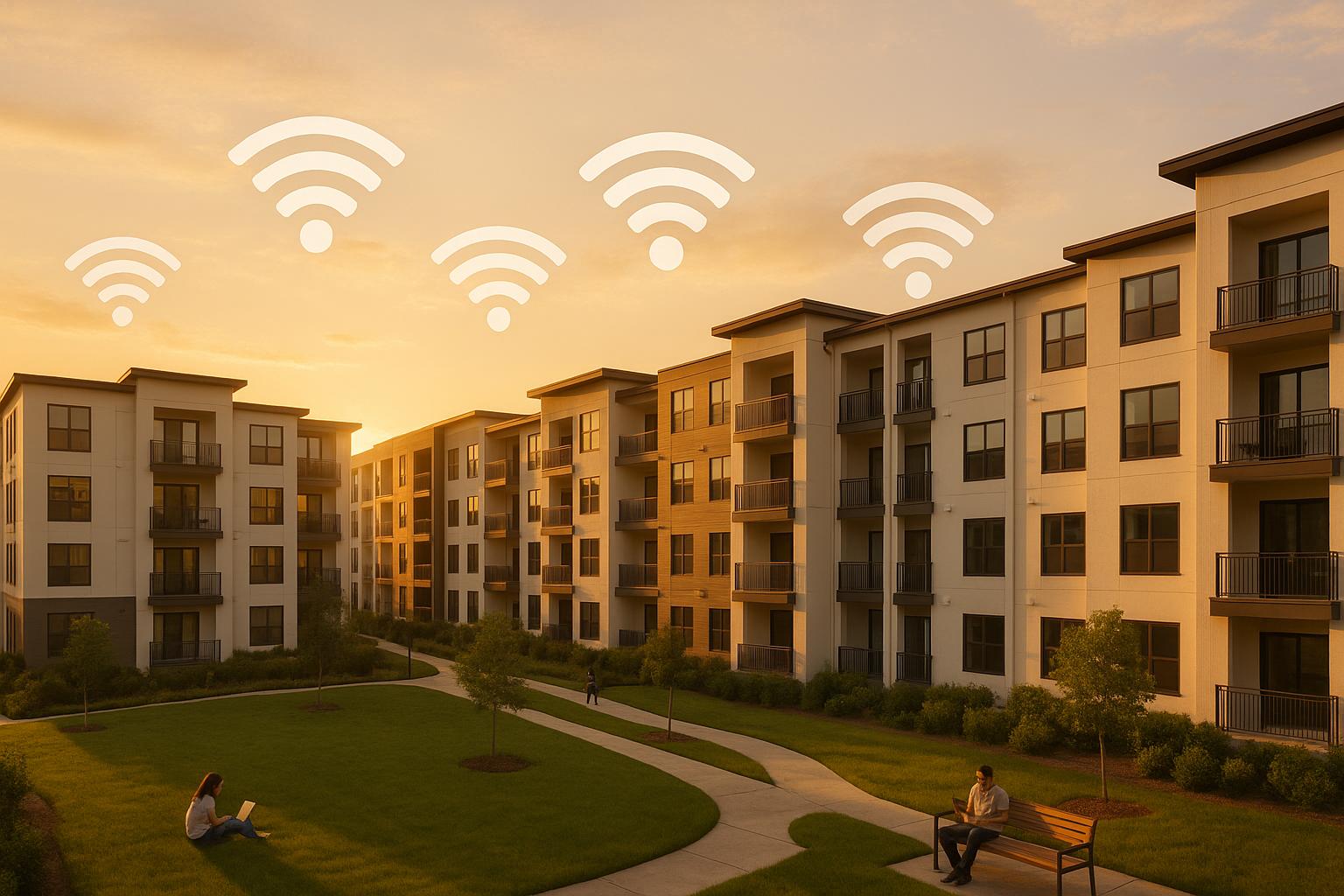Property management software in 2025 is all about integrations - connecting your tools to save time, reduce costs, and improve tenant experiences. Here’s what you need to know:
- Stripe: Simplifies online rent payments with secure processing and real-time updates.
- Plaid: Enables instant bank verification for faster tenant screening and payment reliability.
- TransUnion SmartMove: Delivers quick credit, criminal, and eviction reports to screen tenants efficiently.
- Yardi Breeze IoT: Manages smart devices like HVAC systems, reducing energy use and maintenance costs.
- Nest Thermostat: Optimizes energy usage and automates temperature control for tenant comfort.
- Zillow Rental Manager: Syndicates property listings and streamlines tenant applications and rent collection.
- QuickBooks Online: Centralizes accounting tasks and integrates with property management tools for financial clarity.
Why It Matters:
- 93% of property managers say integrations are essential for operations.
- Automations can reduce manual work by 40% and cut costs by 15%.
- Renters demand digital options: 82% want online payment, and 71% prefer digital communication.
Quick Comparison Table
| Integration | Function | Key Benefit | Setup Complexity | Maintenance |
|---|---|---|---|---|
| Stripe | Payment processing | Secure, real-time payments | Low | Minimal |
| Plaid | Bank verification | Instant tenant screening | Medium | Low |
| TransUnion SmartMove | Tenant screening | Fast credit and background checks | Low | Minimal |
| Yardi Breeze IoT | Smart building tools | Energy savings, maintenance tracking | High | Medium |
| Nest Thermostat | Climate control | Reduces energy use, automates HVAC | Medium | Low |
| Zillow Rental Manager | Listings & applications | Broad tenant reach, online rent payments | Low | Low |
| QuickBooks Online | Financial management | Real-time accounting and reporting | Medium | Medium |
These integrations streamline property management by combining essential tools into a connected system, helping you save time, cut costs, and keep tenants happy.
Best Property Management Software with QuickBooks Integrations
1. Stripe
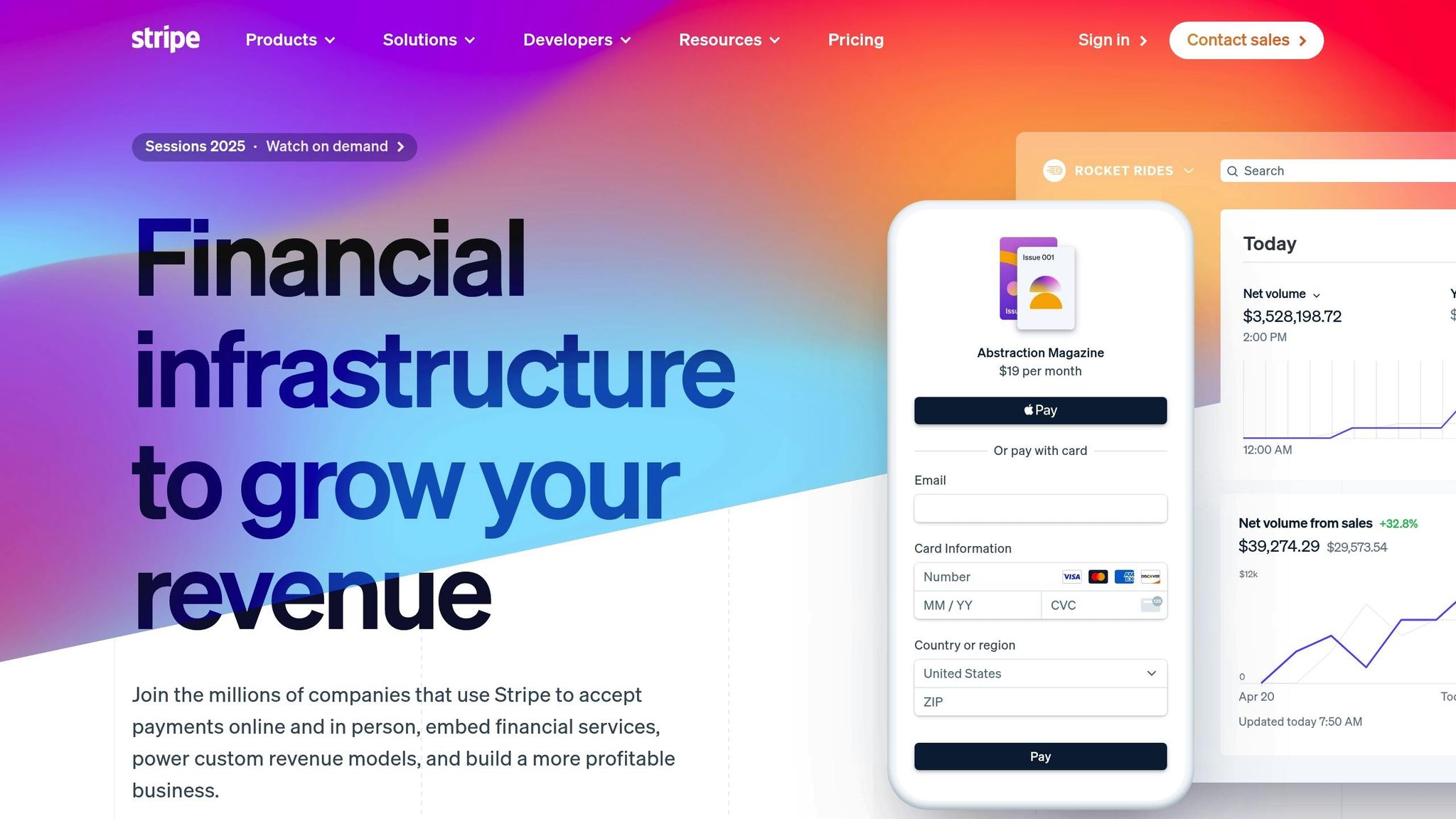
Stripe has become a go-to platform for property management payments, offering a secure and reliable way to handle rent transactions while adhering to U.S. regulations.
Compliance with U.S. Regulations and Standards
When dealing with tenant payments, staying compliant is non-negotiable. Stripe meets the highest industry standards, being certified to PCI Service Provider Level 1 - the top certification in the payments industry [2]. Additionally, its systems undergo regular audits under SOC 1 and SOC 2 programs and align with the NIST Cybersecurity Framework [2]. These measures are designed to safeguard sensitive data and prevent breaches.
"As a payments infrastructure company, our security posture continually evolves to meet the rigorous standards of the global financial industry." [2]
Failing to comply with PCI-DSS standards can lead to steep fines [4], making Stripe's robust security framework a key advantage for property managers.
Easy Integration with Property Management Software
Stripe makes integrating payment processing tools simple and efficient. Features like Stripe Checkout and Stripe Elements use hosted payment fields to securely send sensitive data directly to Stripe's PCI-validated servers [3]. The platform includes a PCI wizard to guide users through compliance requirements [3], while also monitoring for compromised API keys and responding immediately if issues arise [2]. This streamlined setup ensures real-time updates and smooth operations.
Real-Time Data Synchronization
One of Stripe's standout features is its ability to sync transaction data instantly. Once tenants make a payment, the information updates in real-time within your system. For instance, Landing, a property management company, saw a tenfold revenue increase after integrating Stripe [5].
"Stripe had the best suite of tools that would enable us to scale and grow." – Jason Tsai, Finance & Strategy Team, Landing [5]
This real-time synchronization not only optimizes workflows but also improves the overall tenant experience.
Enhancing Daily Operations and Tenant Experience
Digital payments through Stripe simplify daily operations by automating rent collection, eliminating trips to the bank, and reducing the need for paper checks [6]. Property managers can easily handle tasks like sending rent invoices, applying late fees, processing security deposit refunds, and managing multiple bank accounts - all within an integrated platform [8].
For tenants, the convenience of paying rent via debit cards, credit cards, or digital wallets is invaluable. Payments are processed instantly, which is especially important in today’s competitive rental market, where tenant satisfaction plays a big role in retention and ensuring timely payments [7]. Plus, digital transactions offer better security compared to physical checks, reducing risks like fraud and theft [6].
2. Plaid
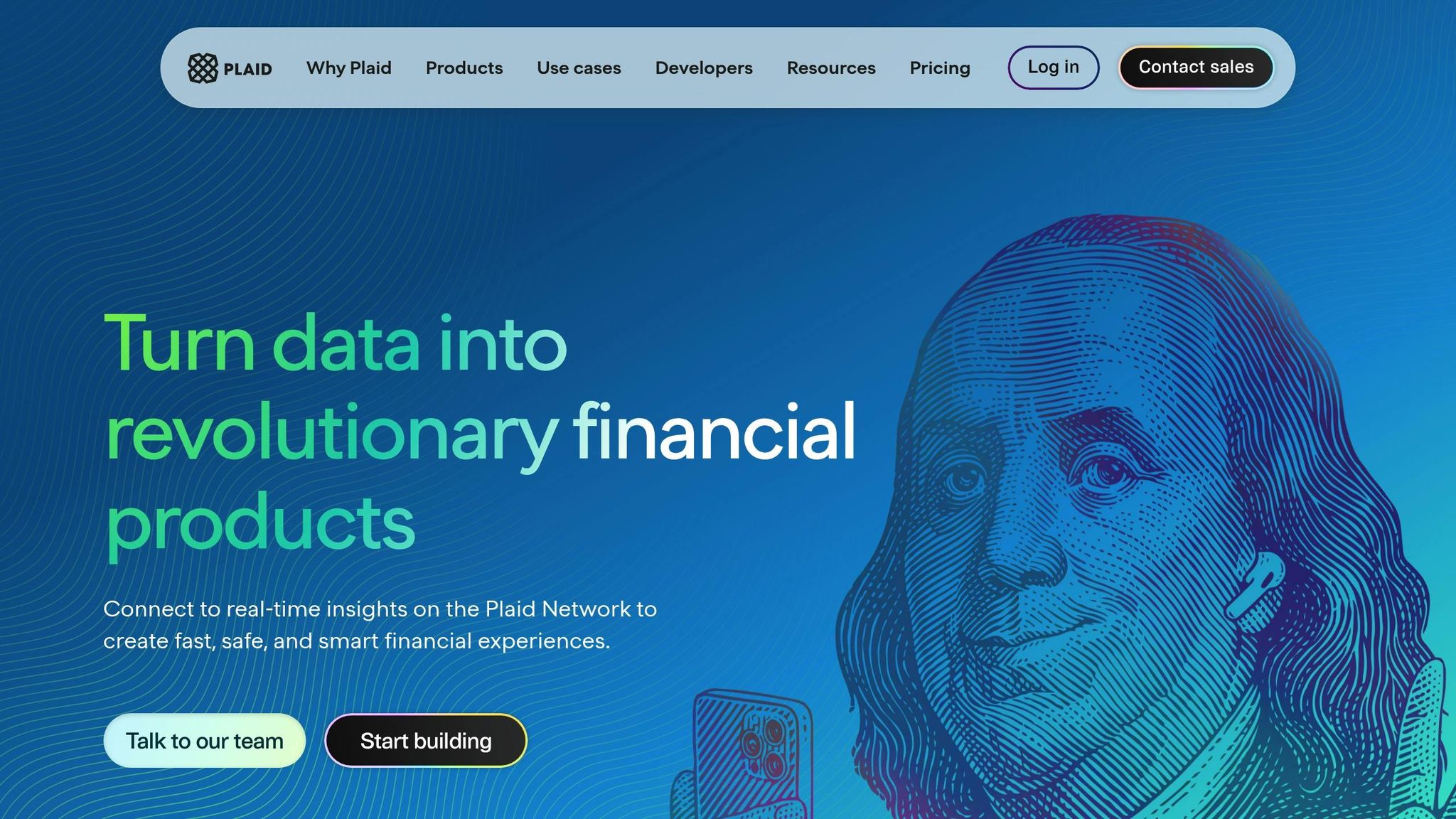
Plaid connects financial institutions with property management software, simplifying tenant verification and payment processes. With access to over 12,000 financial institutions worldwide and powering more than 7,000 financial apps and services [10][11], Plaid plays a pivotal role in modernizing property management workflows. Its integration not only boosts operational efficiency but also ensures compliance with stringent regulatory standards.
Compliance with U.S. Regulations and Standards
Plaid strengthens security and compliance within property management systems. It adheres to federal financial regulations with certifications like ISO 27001, ISO 27701, and SSAE18 SOC 2, while protecting tenant data using AES 256 encryption and TLS protocols [11]. By sharing only the minimum necessary Personally Identifiable Information (PII), Plaid minimizes the risk of data breaches during processes like tenant screening and rent collection [9]. Property managers can also use Plaid's Compliance Center in the Dashboard to meet business information requirements under Section 1033 of the Dodd-Frank Act [12].
Support for Real-Time Data Synchronization
Plaid's ability to sync real-time bank data with property management ledgers significantly reduces the time spent on administrative tasks. Transaction reviews, for instance, drop from 10 hours to just 2, while report preparation shrinks from 5 hours to 1 [14][16]. With an error rate of less than 1%, compared to the typical 5%–10% from manual data entry, Plaid ensures greater accuracy. It also enables instant income verification and helps prevent tenant overdraft fees [15].
Enhancing Daily Operations and Tenant Experience
Plaid goes beyond improving efficiency - it transforms overall operations. For example, Building Stack saved over $400,000 in fees during its first year, quadrupled customer bank account connections, and avoided $36,000 monthly in credit card and NSF fees [13][19].
"Plaid's advanced tools help us ensure applicants are who they say they are with a balance of speed and reliability, aligning with our company's commitment to innovation and excellence." - Senior leader, Invitation Homes [13]
Tenant screening processes have also seen remarkable improvements. Invitation Homes reduced its lead-to-lease time by 60%, Canopy cut resident verification time from 5 days to just 60 seconds, and PadSplit decreased manual verifications by 70% [13]. Rent App achieved a 50% month-over-month drop in delinquency rates and slashed third-party fraud by 90%, with approval decisions now taking as little as 10 seconds [18].
"The Plaid brand is increasingly recognized by users, who associate it with a secure, trustworthy experience. That familiarity helps renters feel more confident when linking their bank accounts - reducing friction and improving overall conversion." - Leonid Movsesyan, Co-Founder and Chief Technology Officer, Rent App [18]
In 2024, RentRedi expanded its Plaid integration to streamline tenant screening further, allowing landlords to verify income and assets of prospective renters more effectively [17]. Up next, we’ll look at how TransUnion SmartMove enhances property management software even further.
3. TransUnion SmartMove
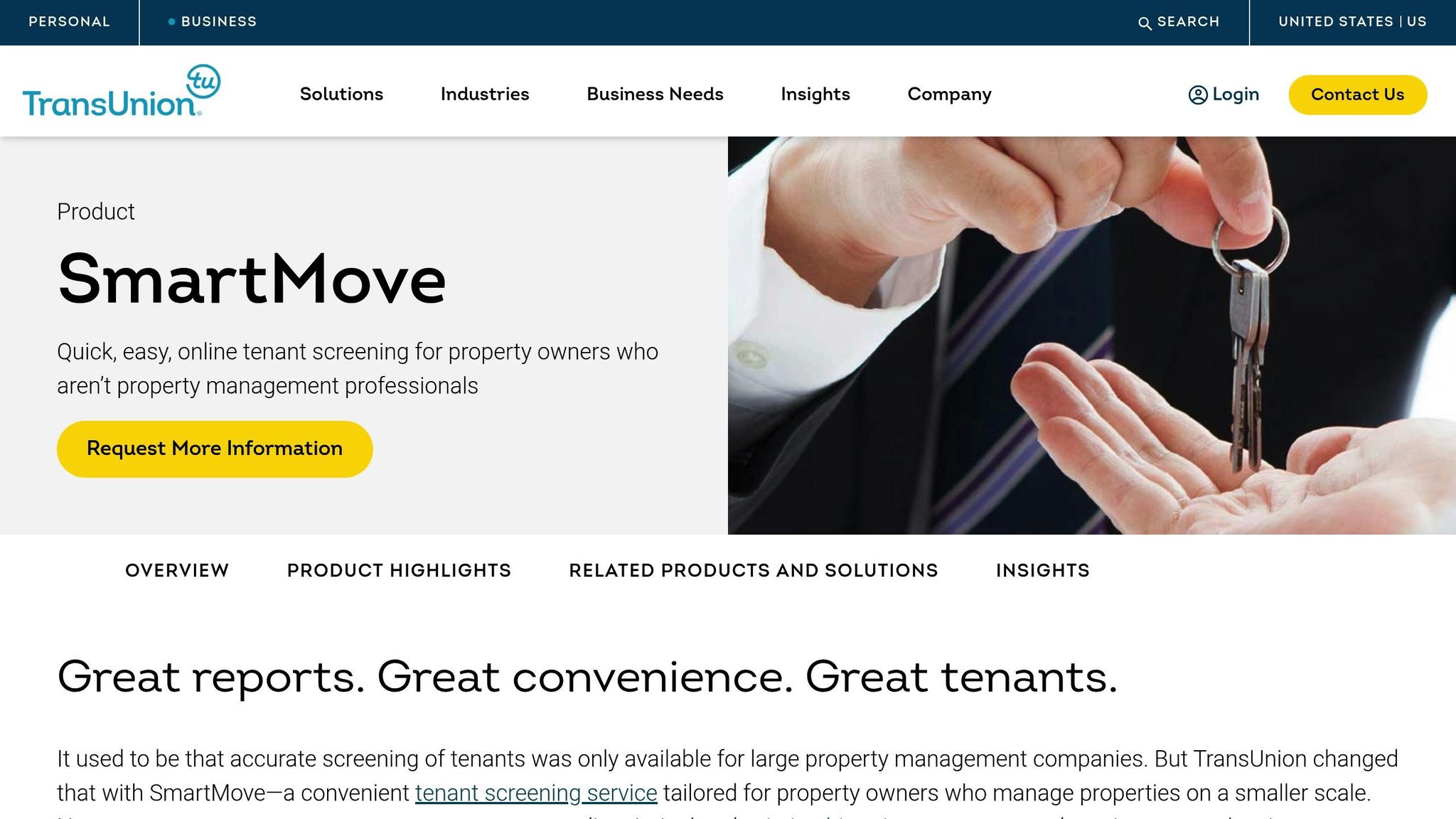
TransUnion SmartMove is an online tenant screening platform tailored for independent landlords and small property managers. It offers quick access to essential screening tools, including credit, criminal, and eviction reports, all delivered within minutes [35,39].
Compliance with U.S. Regulations and Standards
SmartMove ensures its processes align with the Fair Credit Reporting Act (FCRA), guaranteeing compliance with federal regulations. Applicants must provide online consent before their screening results are shared with landlords, making the process transparent [21]. Under FCRA rules, tenants can dispute inaccuracies in their reports, while landlords are required to use these reports solely for legally permitted purposes [21].
Easy Integration with Property Management Software
Getting started with SmartMove is hassle-free. There are no setup fees or waiting periods, allowing property managers to begin screening tenants immediately [20]. The platform works entirely online and integrates seamlessly with most property management software without requiring complicated technical setups. Additionally, landlords can choose to have applicants pay the screening fees, which helps minimize operational costs [20]. Pricing options include four tiers: Background Check Basic and SmartCheck Basic at $25 each, SmartCheck Plus at $40, and SmartCheck Premium at $47 [34,39].
Real-Time Data Access for Faster Decisions
SmartMove delivers screening reports quickly - often within minutes after verifying an applicant’s identity [22]. This speed enables property managers to make quicker leasing decisions and stay competitive in the market. The platform’s ResidentScore technology predicts eviction risks 15% more effectively than traditional credit scores, providing landlords with more reliable tenant evaluations [34,39]. Comprehensive background checks scan millions of records, producing detailed and accurate reports that eliminate guesswork. This streamlined process helps managers assess tenants efficiently and confidently.
Enhancing Daily Operations and Tenant Experiences
SmartMove simplifies property management by reducing the time and effort required for tenant screening, helping landlords fill vacancies faster [20]. According to user feedback, 9 out of 10 users recommend the service for identifying reliable tenants [20].
"An easy-to-use online tool, MySmartMove.com has already helped me streamline my screening process, eliminating the need to secure applicant data while objectively providing me with a recommendation and suggested deposit", said Donna Taylor, a rental owner from Arvada, Colorado [23].
Thorough screening also has a significant financial impact. Evictions, which cost an average of $3,500 per incident, can often be avoided with SmartMove’s detailed reports. Research from TransUnion shows that evicted tenants are nearly three times more likely to have prior eviction or rental-related collections than those who are not evicted [24]. Additionally, during the 2016–2017 screening period, 28% of applicants screened through SmartMove had a criminal record [24].
4. Yardi Breeze IoT
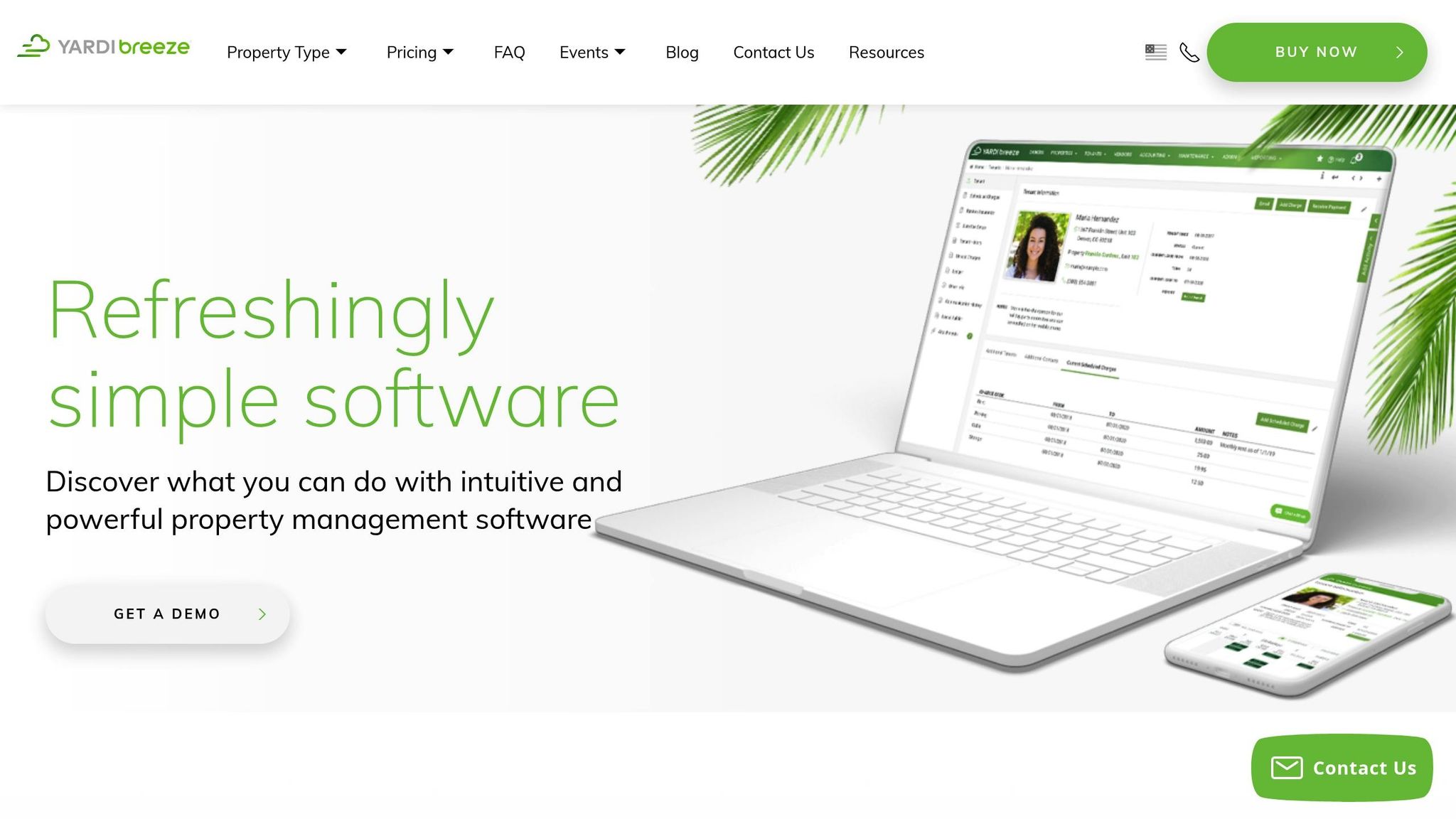
Yardi Breeze IoT is a smart building solution designed for small to mid-sized property portfolios. It connects Internet of Things (IoT) devices directly to property management software, creating a single ecosystem that tracks everything from energy usage to equipment performance in real time.
This tool also simplifies compliance processes, which is especially important for affordable housing providers.
Compliance with U.S. Regulations and Standards
For affordable housing providers, staying compliant with regulations can be complex. Yardi Breeze IoT simplifies this by documenting applicant eligibility, guiding calculations, and supporting properties involved in programs like Low-Income Housing Tax Credit, HUD 50059, Rural Development, and HOME programs [26]. For properties that need extra assistance, Yardi RightSource provides scalable services such as agency reporting and voucher processing, cutting down on compliance costs and complications [25]. Additionally, the platform includes built-in reporting templates that can export data in various formats and integrate with online reporting systems for easy electronic submissions [26].
Real-Time Data Updates and Synchronization
Yardi Breeze IoT goes beyond compliance by offering real-time synchronization of IoT device data across all connected systems. This ensures property managers always have the most up-to-date information [28]. With real-time updates, managers can quickly track incidents, monitor maintenance, and identify equipment issues [28][29]. The platform’s alerts and monitoring features help reduce maintenance expenses by up to 25%, unplanned outages by up to 50%, and energy consumption by 10–15% [30].
Enhancing Daily Operations and Tenant Experience
By integrating key metrics and providing real-time updates, Yardi Breeze IoT simplifies daily operations and improves the tenant experience. It consolidates essential data - like occupancy rates, rent collection, and maintenance requests - into a single platform. Features like online rent payments, streamlined lease management, and real-time status updates make life easier for both property managers and tenants [32][33]. Tenants can submit maintenance requests, access important information, and track updates effortlessly, while property managers can gather feedback through custom surveys to boost tenant satisfaction [32].
The platform’s user-friendly design works on any device, offering flexibility for both staff and residents [31]. With a 4.1 out of 5 rating from users [33], Yardi Breeze IoT is clearly meeting expectations. Its success reflects the broader growth of the U.S. property management software market, which accounted for 73.0% of North America’s share in 2023, with the residential segment making up 65.6% [27].
sbb-itb-58157f8
5. Nest Thermostat Integration
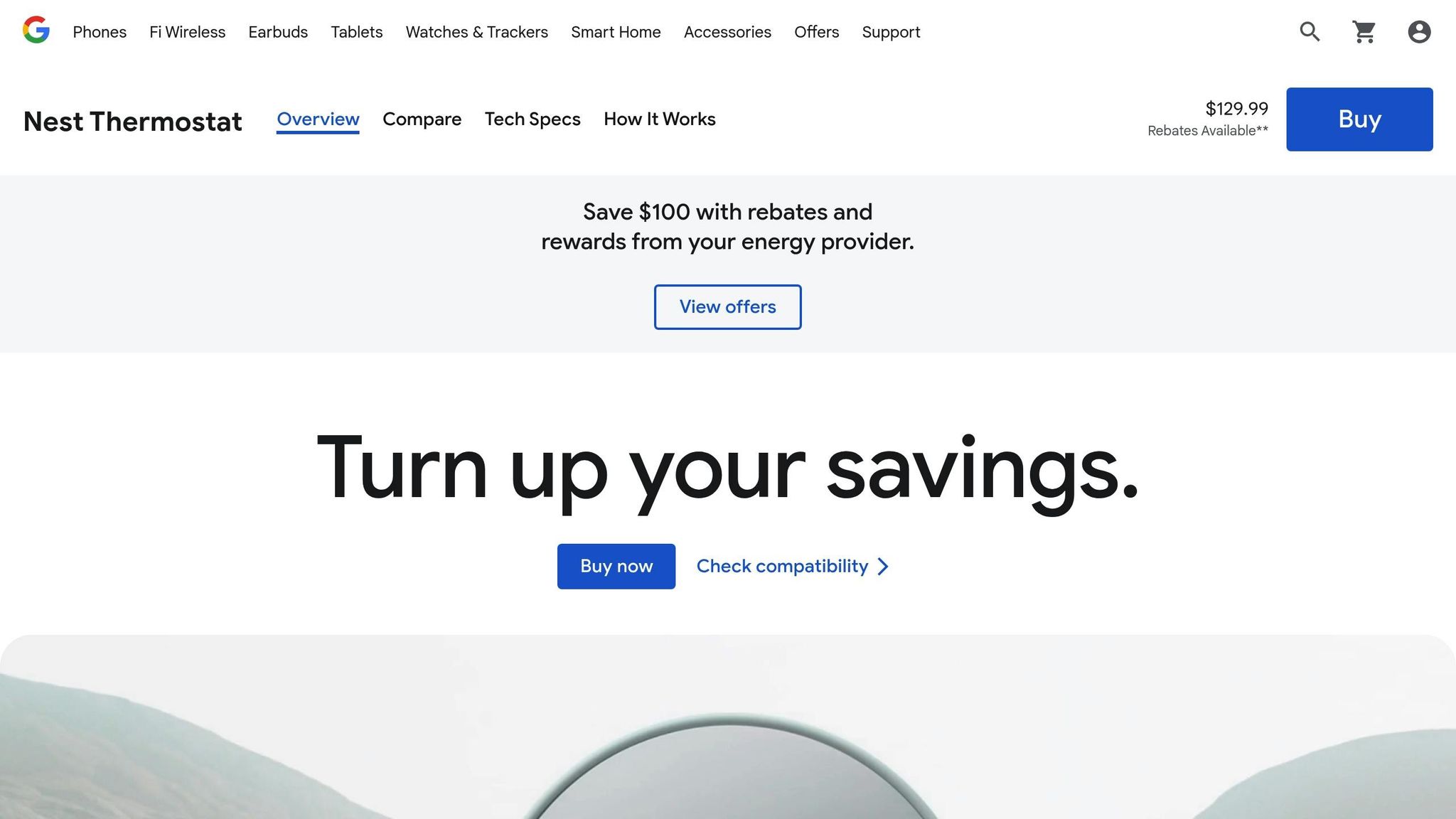
Building on the earlier discussion about payment and screening integrations, Nest Thermostat integration showcases how smart devices are reshaping operational efficiency in 2025. Google Nest thermostats help reduce energy expenses and improve tenant satisfaction by automating HVAC systems to align with occupancy and user preferences.
Compliance with U.S. Regulations and Standards
The U.S. Department of Energy's energy efficiency standards for 2025 have introduced stricter requirements for HVAC systems in residential properties. These include updated SEER2 ratings for cooling and HSPF2 ratings for heating. Nest thermostats play a key role in helping properties meet these regulations while also unlocking financial benefits through automatic energy optimization [34] [36].
For example, the Energy Efficient Home Improvement Credit offers up to $1,200 annually for energy-efficient upgrades, with heat pumps qualifying for up to $2,000 per year [35]. Additionally, utility companies like Nicor Gas provide discounts on Nest models, such as the Google Nest 2020 Smart Thermostat priced at $140 and the Nest Learning Smart Thermostat at $250, both with free installation included [37].
Seamless Integration with Property Management Software
Modern property management platforms can directly integrate with Nest devices through APIs, allowing centralized control across entire property portfolios. Property managers can link check-in and check-out schedules with their Property Management Systems or Airbnb integrations. This ensures thermostats automatically adjust, creating a comfortable environment for tenants upon arrival [39].
Several property managers have successfully tested Nest integrations to optimize HVAC controls across their portfolios. Once implemented, Nest devices provide continuous data updates that enhance operational efficiency.
Real-Time Data Synchronization
Real-time synchronization provides instant updates on temperature and energy usage. This feature allows property managers to remotely control heating and cooling systems, leading to cost savings and smoother operations.
In August 2024, Minut partnered with Google Nest to automate temperature control in short-term rentals. The integration works with multiple Nest models, enabling property managers to automatically turn off HVAC systems when guests check out, while maintaining safe temperature levels [39].
"At Minut, we recognize that it is part of our responsibility to promote sustainability within the short-term rental industry. By integrating with Google Nest, we're enabling property managers to cut energy costs and streamline operations, supporting both eco-friendly practices and financial savings while ensuring a comfortable experience for guests."
– Katrin Humal, Product Manager at Minut [39]
This real-time connectivity supports smarter and more energy-conscious daily operations.
Enhancing Daily Operations and Tenant Experience
Smart thermostats bring tangible benefits to both operational efficiency and tenant satisfaction. With HVAC systems accounting for over 35% of a building's energy use, smart systems can reduce runtime by up to 40% and cut energy consumption by 10–15%. Commercial property managers often see a return on their investment within just 12 months [38] [40] [42].
For tenants, Nest integration offers programmable temperature settings that cater to their preferences and schedules. Property managers can also use smart thermostats in shared spaces, programming them to adjust during peak usage times. This approach not only reduces energy consumption but also meets modern renters' expectations for convenience and connectivity [40] [41].
6. Zillow Rental Manager

Zillow Rental Manager offers property management tools that connect managers to a massive tenant audience, leveraging its status as the most visited rental network in the U.S.
Compliance with U.S. Regulations and Standards
Zillow Rental Manager simplifies compliance by automatically adjusting its application and screening processes to align with state and local laws across the country [48]. Its tenant screening features include nationwide eviction checks, criminal background searches, and sex offender registry searches, all in accordance with Fair Credit Reporting Act (FCRA) guidelines [48]. The platform also provides customizable lease agreement templates that incorporate local ordinances and state-specific rental laws [49].
"In some cases, application components, such as background checks or credit reports, are modified to reflect state and local legal requirements." - Zillow Rental Manager [48]
By automating these legal adjustments, the platform reduces the burden on property managers to stay updated on changing regulations, lowering legal risks and saving time.
Seamless Integration with Property Management Software
Zillow Rental Manager integrates easily with property management platforms via APIs tailored for multifamily property managers [44]. These APIs support both free and paid options, enabling property managers to sync property data directly with Zillow's listing platform. This eliminates the need for manual data entry and ensures marketing efforts stay consistent across channels.
Real-Time Data Synchronization
The platform supports real-time data updates, keeping property listings, tenant applications, and availability statuses current across all connected systems. Listings are syndicated across Zillow, Trulia, and HotPads, reaching a broad audience while centralizing data management [43]. With Zillow attracting 30 million monthly visitors [47] and generating over 176 million tenant contacts in 2022 [44], property managers gain extensive exposure. Additionally, the integrated dashboard allows managers to monitor application statuses, screening results, and tenant communications in real time, making daily operations more efficient.
Enhancing Daily Operations and Tenant Experience
Zillow Rental Manager consolidates essential property management tasks - like listing management, tenant screening, and rent collection - into one platform. It delivers over 3.2 million rental prospects monthly for multifamily properties, significantly expanding tenant reach [44].
"Zillow simplifies the whole rental process from listing to leasing to applications and payments." - Jeff C., OK [43]
The platform boasts an 88% user satisfaction rating, emphasizing its impact on operational efficiency [46]. Through the system, property managers can create rental applications that prospective tenants complete online. These applications include integrated credit checks, background checks, and eviction history reviews, with screening reports available for $29 per applicant [45]. For rent collection, tenants have flexible payment options, including credit cards (2.95% fee), debit cards ($9.95 fee), and free ACH transfers, ensuring timely payments and steady cash flow for managers.
Mobile accessibility further enhances convenience, allowing property managers to communicate with tenants, review applications, and process payments from anywhere - perfect for the increasingly flexible work environments of today.
7. QuickBooks Online
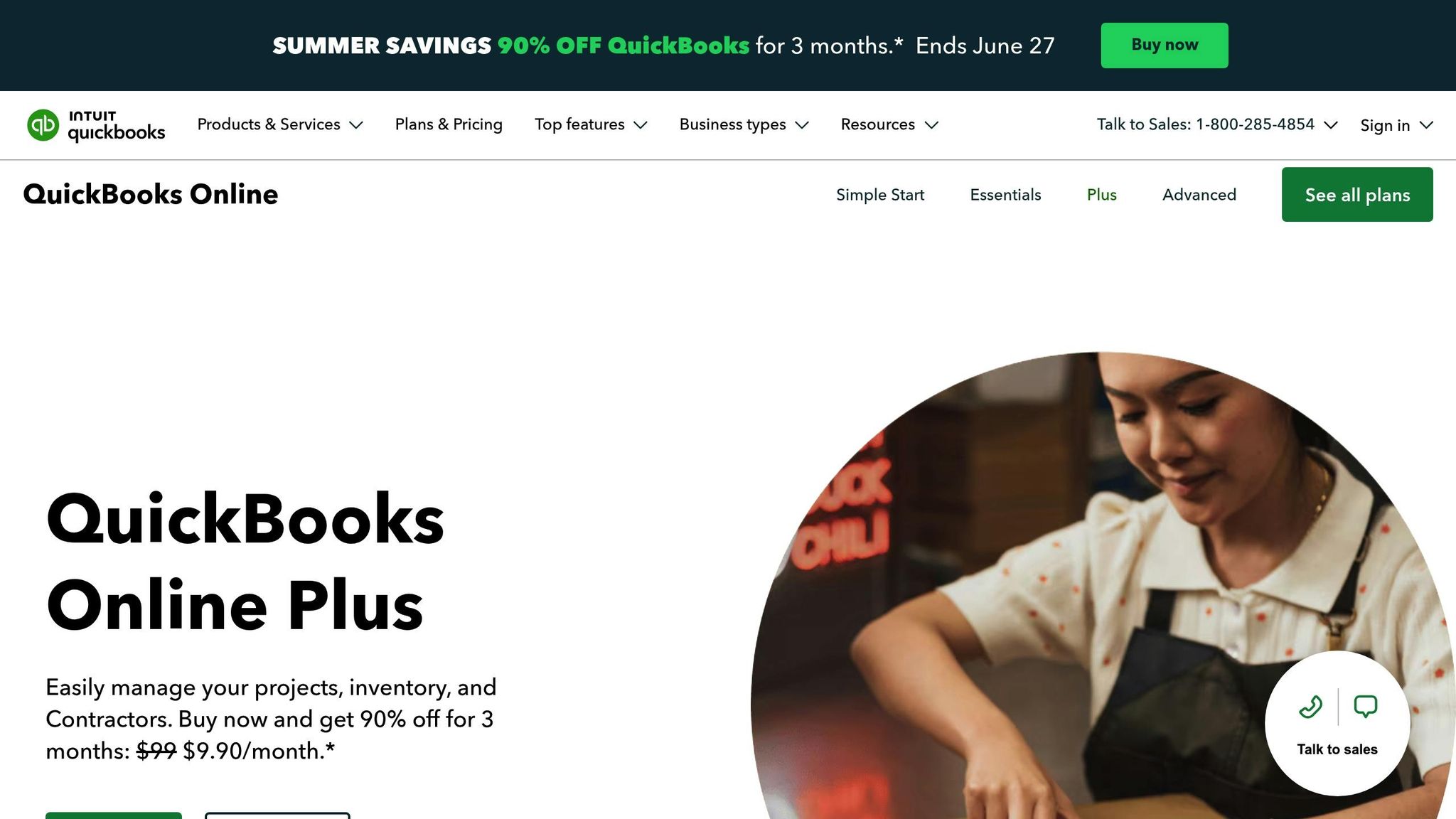
In multifamily property management, financial management is just as important as tenant engagement and operational efficiency. QuickBooks Online serves as a centralized accounting hub tailored to the needs of property managers. With 91% of clients achieving their 2024 growth goals by streamlining accounting processes [55], this tool has become a go-to solution for those looking to simplify operations and gain financial clarity.
Compliance with U.S. Regulations and Standards
QuickBooks Online ensures compliance with U.S. financial regulations by offering strong financial controls and simplifying tax preparation. It automatically categorizes income and expenses, while maintaining a clear audit trail for easy oversight [50][51]. This feature is particularly helpful during tax season, as property managers need to meet IRS requirements for rental income and deductions.
"Effective finance and controls are key to strong financial management, helping your business maintain accuracy and full compliance." – Marshall Hargrave, Financial Writer [50]
By integrating seamlessly with other property management tools, QuickBooks Online keeps financial operations as streamlined and connected as tenant services and building management.
Seamless Integration with Property Management Software
The platform’s two-way integration eliminates the need for manual data entry by syncing property management data in real time [52][53][56]. Property managers can organize properties as customers and tenants as sub-customers, making it easier to track transactions [51]. This real-time connectivity ensures financial data flows smoothly between systems, improving accuracy and efficiency.
Real-Time Data Synchronization for Better Decision-Making
Real-time syncing not only reduces errors but also supports proactive decision-making. With up-to-date financial reports, property managers gain immediate insights into a property’s performance [54]. This enables faster decisions and more accurate budget planning. Advanced integrations can reduce manual work by up to 80% [52]. Despite these advancements, 61% of real estate firms still rely on outdated systems for their core operations [52].
Enhancing Daily Operations and Tenant Satisfaction
QuickBooks Online simplifies day-to-day property management by centralizing financial tasks like tracking rental income, property expenses, and other transactions [51]. Automatic rent payments and invoice generation make rent collection easier, reducing missed payments and ensuring steady cash flow [51]. Many tenants appreciate the convenience of online payment options for their monthly rent [55]. Additionally, the platform’s expense tracking tools allow managers to categorize costs - such as maintenance, utilities, and property taxes - helping them make informed decisions [51]. Its scalable and intuitive design makes it a practical choice for both small-scale property managers and those handling larger, more complex portfolios [51].
Feature Comparison Table
Integrations play a crucial role in simplifying property management, and the table below highlights the trade-offs and advantages of some key tools. It provides an at-a-glance comparison of their functions, benefits, setup requirements, and potential drawbacks.
| Integration | Primary Function | Key Benefits | Setup Complexity | Maintenance | Potential Limitations |
|---|---|---|---|---|---|
| Stripe | Payment Processing | Supports ACH, credit cards, and international payments; widely adopted | Low – easy API integration | Minimal – automatic updates | Transaction fees can become costly with high volumes |
| Plaid | Bank Account Verification | Enables instant bank verification for reliable payments | Medium – requires security compliance setup | Low – occasional security reviews | Limited to U.S. and Canadian banks |
| TransUnion SmartMove | Tenant Screening | Provides fast access to credit, criminal, and eviction reports | Low – simple plug-and-play integration | Minimal – automated report delivery | Per-screening charges and tenant consent required |
| Yardi Breeze IoT | Smart Building Management | Centralized control over HVAC, lighting, and security | High – may need on-site hardware installation | Medium – regular firmware updates | High initial hardware costs |
| Nest Thermostat | Climate Control | Remote temperature management and potential energy savings | Medium – WiFi setup and API configuration | Low – automatic cloud updates | Requires stable internet and ties to Google’s ecosystem |
| Zillow Rental Manager | Marketing & Listings | Syndicates listings across multiple rental platforms | Low – direct feed integration | Low – automatic updates | Limited customization options due to Zillow’s policies |
| QuickBooks Online | Financial Management | Real-time synchronization and streamlined accounting | Medium – requires initial chart of accounts setup | Medium – monthly reconciliations | Subscription fees and a learning curve for complex tasks |
Security and compliance remain critical. Property managers should prioritize tools that provide detailed contract access, covering active agreements, renewal dates, and key terms [59].
While tools like Stripe and Plaid are excellent for handling high transaction volumes, IoT solutions such as Yardi Breeze often require significant hardware investments upfront. QuickBooks Online offers flexible pricing tiers, catering to both small-scale operations and larger portfolios.
Cost structures vary between transaction-based and fixed pricing models. IoT solutions, in particular, demand higher initial investments and ongoing maintenance. Selecting the right integrations depends on how well they fit within your broader property management strategy.
For example, you’ll want software that supports seamless customization and connects with essential tools for tenant screening, marketing, leasing, inspections, and financial management [57]. Starting with smooth integration into your existing accounting software can lay a solid foundation for an efficient tech stack [58].
This table provides a clear snapshot of how these integrations align with the demands of modern property management.
Conclusion
Integrations have completely reshaped property management, turning it from a tedious, paper-heavy process into a smooth, digital-first operation that meets the demands of today’s U.S. market. With the property management software industry expected to hit $5.51 billion by 2025 [61], these tools are no longer optional - they’re a necessity for staying ahead.
"In 2025, property management is no longer about juggling paperwork, playing phone tag, and reacting to problems. It's about proactive management, digital convenience, and leveraging data to deliver superior service."
- Ava Bennett, SEO Manager at Rentaaa [62]
This shift reflects the growing emphasis on efficiency, convenience, and data-driven decision-making in modern property management.
By bringing together all the key aspects of property management into one cohesive ecosystem, these integrations deliver real results. They can lower operational costs by 20–30% and reduce energy expenses by 15–30% [1].
Renters are also demanding more digital options, with 78% of them placing high value on online payment systems. Meanwhile, automation has proven to lighten administrative workloads by 25% [64][63].
Another major advantage? Compliance. Automated lease generation and electronic signatures make it easier for property managers to navigate complex regulations, reducing legal risks along the way [60].
As Stacey Salyer, founder of Property Management Strategist, puts it:
"Property management software serves as a communication hub, automating messages between vendors, tenants, and me. It allows real-time communication within work orders, which was revolutionary at the time when I first started working with it." [60]
These tools are not just about saving time - they’re about transforming the way property managers connect with tenants, vendors, and their own teams, setting the stage for a more efficient and proactive future.
FAQs
How do integrations in property management software improve tenant satisfaction and retention?
Property management software integrations play a crucial role in boosting tenant satisfaction and retention by streamlining essential processes and enhancing communication. Features like automated rent payments, real-time updates on maintenance requests, and user-friendly communication tools simplify daily interactions for tenants, cutting down on delays and reducing frustrations.
Additionally, advanced technologies like AI-driven chatbots and IoT-enabled devices make resolving issues quicker and provide a more tailored service. These tools help create a smoother, more efficient experience that prioritizes tenant needs, building trust and long-term loyalty.
What compliance factors should be considered when integrating financial tools like Stripe and Plaid with property management software?
When using financial tools like Stripe and Plaid with property management software in the U.S., staying compliant with regulations is a must. This means following KYC (Know Your Customer) and AML (Anti-Money Laundering) rules while ensuring top-notch data security to safeguard sensitive financial details.
Both platforms prioritize privacy and transparency. For example, user data must be managed securely and in accordance with federal and state laws that govern consumer protection and financial privacy. To maintain compliance, it’s critical to collaborate with legal and compliance professionals, adopt secure data handling practices, and perform regular audits. These steps not only help you meet changing regulations but also strengthen user trust.
How can property managers determine if IoT solutions like Yardi Breeze IoT and Nest Thermostat are cost-effective?
Property managers looking to make smart financial decisions should weigh the potential of IoT solutions to cut costs and streamline operations. Take smart thermostats or predictive maintenance tools, for example. These devices can help lower energy consumption and catch maintenance issues early, saving money on utility bills and avoiding expensive repairs.
When evaluating the value of IoT, it’s essential to balance the initial investment against the long-term benefits. These benefits might include lower energy expenses, fewer emergency repair calls, and happier tenants thanks to better temperature control and increased reliability. Over time, the cost savings and operational improvements often offset the upfront costs, making IoT solutions a worthwhile consideration for property management.


